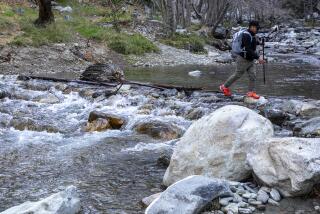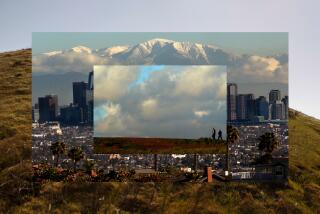Riding Areas Shrink as Mountain Bikes Grow Popular
- Share via
When Rick Goeden heard about a contraption called a mountain bike, he thought he had discovered the perfect sport.
He had tried riding a bicycle on the streets near his Santa Monica apartment but wasn’t fond of inhaling exhaust fumes. He had tried hiking in the Santa Monica Mountains, but that was too slow for him.
The mountain bike, also known as the off-road bike, promised to combine the best of both pastimes, allowing for fast pedaling through the spectacular scenery of the hills. For about $400, it would give him two fat, sturdy tires that could grip the road and 18 gears for going up and down steep slopes. Goeden went out and bought one.
There was a catch, however, and Goeden found out about it on his first outing, a ride to Will Rogers State Historic Park. “The ranger at the gate told me to stay away from the trails,” he recalled recently. “In fact, the ranger came on pretty strong and said, ‘You better not go (on them) or you’ll be ticketed.’ ”
Over the last year, territory for bike riding in the Santa Monica Mountains has become more and more limited as the bikes themselves become more and more popular. The state Department of Parks and Recreation and the National Park Service have banned bikes from most trails in the area, allowing them for the most part only on wide, level fire roads built for emergency vehicles and dismissed by the bikers as unchallenging and less than scenic.
The third major public landowner in the hills, the Santa Monica Mountains Conservancy, is to consider a similar policy Tuesday night.
Rangers, hikers and equestrians say the growing opposition to mountain bikes stems from safety problems and environmental damage to the trails during the five years since mountain bikes were first mass-produced. They talk of bikers careening down hillsides at speeds up to 40 m.p.h., injuring themselves, colliding with hikers and scaring horses. They describe rutted, uneven trails and fragments of shattered reflectors littering the paths.
The bikers acknowledge that some of their number have been inconsiderate and insensitive on the trails. But they say “the kamikazes,” as they refer to the speed demons, are a distinct minority. They see the new rules as discrimination against one group of sports lovers who have as much right as the others to use public land.
Other mountain parks in the Los Angeles area, however, may also ban the bikes from the trails. Officials of Angeles National Forest and Los Padres National Forest, where most trails are now open to bikes, are studying the matter.
Biking on the mountain areas of Catalina Island was banned July 1.
As the sport is taken up by others in California, “it’s probably coming to the point where it’s going to have to be addressed on a statewide basis,” said John D. Hart, safety officer for the state parks.
“The Los Angeles Basin, Santa Barbara, the Bay Area and the Boulder, Colo., area are the places where the sport is established in sufficient numbers to be visible,” said Glenn Odell, executive director for land access of the National Off-Road Bicycle Assn. “And those are the places where we’re seeing the threat of closures.”
Odell doesn’t think the bans are fair.
“If there’s a litter problem along the John Muir Trail, they don’t exclude the backpackers from the trail,” he said. “Those users are a given. But off-road bicycling is still suffering from a lack of clout, being the new kid on the block.”
He said he expects that to change because “there are simply too many people participating. . . . It’s not a fad.”
Indeed, sales of mountain bikes have doubled in the United States every year since 1982, when retailers introduced them. About 2.6 million were in use around the country by the end of 1986, most of them in the West, according to Bill Wilkinson, executive director of the Washington-based Bicycle Federation of America. He expects that number to reach 5 million by the end of this year.
About 80% of mountain bike owners ride exclusively on the streets, Wilkinson said. “But that still leaves a significant number that want to use the trails,” he said. “A system is undergoing realignment. It’s a new activity and it needs to find a place and fit in the scheme of things.”
After similar debate, motorized recreational vehicles found their niche, even if it’s a distant one. In the mid-1970s, the state set aside five mountain parks for motorcycles, as well as for three- and four-wheeled all-terrain vehicles. The closest one to Los Angeles, however, is in Hungry Valley, 20,000 acres near the north Los Angeles County town of Gorman.
“The motorized vehicles are much worse than the bikes when it comes to damage, and they are very fast,” said Randy Sederquist, resource ranger for the Santa Monica Mountains District of state parks. “However, we have special funding to accommodate them and we don’t have that funding for the bikes. The vehicular recreation areas have the manpower for monitoring and enforcement.”
Not Optimistic
He is not optimistic about the possibility of getting such money for mountain bikes. “We aren’t going to get more land, and we aren’t going to get more staffing, not in these days of budget cuts,” he said.
Goeden, a 39-year-old YMCA program director, is one of eight bikers who have banded together to seek a compromise in the Santa Monica Mountains. Calling themselves Concerned Off-Road Cyclists, they have telephoned and written to park officials asking that trails be open to bikes at least part of the time. They suggest speed limits, designated bike-only trails or periodic weekends when bikes would be permitted on trails.
In return, “I think a lot of the mountain bikers would be interested in helping to maintain the trails,” Goeden said.
Another member of the group, 34-year-old brokerage executive Bonnie Hill, added: “I’m sure riders would be glad to volunteer to patrol too.”
The two stood at a curve on the one path in Will Rogers where their bikes are allowed, a wide dirt road leading to Inspiration Point. Below them, the tops of the white, boxy buildings of downtown Santa Monica could be glimpsed above the trees. The sun, low in the western sky, glinted off an ocean dotted with sailboats returning to shore.
“It’s beautiful,” Goeden said. “But while it’s a good hike for hikers, for a mountain biker, it’s just a 10-minute ride to the top.”
Good Old Days
As the no-biking signs are posted, the group’s members grow nostalgic for rides that once were legal. Harald Johnson remembers when he could leave the Will Rogers path for the Backbone Trail, which links various parks in the mountains. And Woody Compton pines for night excursions through Topanga State Park.
“We’ve done full-moon trips,” Compton said, “and the hills are just these dark shapes. . . . We watch the moon come up through the smog and we climb up above the clouds and drop down below.
“It’s a shame that the behavior of a few people means the rest of us have to give this up,” Compton said.
Local park officials agree. They say they have nothing against the equipment itself. The state Parks Department has two mountain bikes for rangers to use on patrol at Topanga and Malibu Creek state parks. The Conservancy finances a mountain bike program at Point Mugu State Park for disadvantaged youths.
But the problems, rangers say, have been too dramatic to ignore.
Broken Bones
“There are quite a few wrecks,” said Jeff Snider, supervising ranger at Point Mugu and at Leo Carrillo State Beach, which also includes some upland trails. “We’ve had broken collar bones and broken arms and lacerated legs and broken backs. We’ve had them collide with hikers. We’ve had them collide with people on horseback.”
Sixteen bike-related accidents resulting in serious injury have been reported in the Santa Monica Mountains District of state parks since 1984.
On a holiday weekend or when the weather is good, “we might have 400 to 600 hikers and 100 bicyclists” in Point Mugu’s 15,000 acres, Snider said. If allowed on the trails, “a biker would cross paths with a hiker just about anytime.”
The solutions suggested by Concerned Off-Road Cyclists, rangers said, are too complicated to implement.
They have enough trouble enforcing the roads-only regulation.
No more than five rangers are on duty at Point Mugu on any given day, and no more than two rangers staff other state parks in the Santa Monicas. They can’t possibly watch every trail.
Citations Handed Out
So far this year, rangers have cited about 15 people for riding mountain bikes illegally, Sederquist said. “We’re sure more violations are occurring. We just don’t see them,” he said.
In May, Pat Mullen and Kregg Koch of Thousand Oaks were among four teen-agers who found a ranger waiting at the bottom of a hill along a trail in the Point Mugu park. He handed out $15 citations.
Koch still laughs when he thinks about what happened next. “We took the tickets and waited for the ranger to leave,” he said, “and then we just sneaked back in.”
Since then, Mullen said, “we haven’t stayed away. We’ve just been more careful. We saw a coyote yesterday, and rattlesnakes.”
More to Read
Sign up for Essential California
The most important California stories and recommendations in your inbox every morning.
You may occasionally receive promotional content from the Los Angeles Times.













